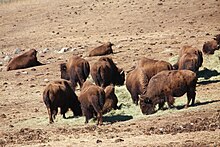
Back نزعة اجتماعية Arabic Sosyalidad BCL Socialitat Catalan Gregäres Verhalten German اجتماعیگری Persian Socialité French Szociális viselkedés Hungarian Sosialitas ID 社会 (生物) Japanese 동물사회성 Korean

Sociality is the degree to which individuals in an animal population tend to associate in social groups (gregariousness) and form cooperative societies.
Sociality is a survival response to evolutionary pressures.[1] For example, when a mother wasp stays near her larvae in the nest, parasites are less likely to eat the larvae.[2] Biologists suspect that pressures from parasites and other predators selected this behavior in wasps of the family Vespidae.
This wasp behaviour evidences the most fundamental characteristic of animal sociality: parental investment. Parental investment is any expenditure of resources (time, energy, social capital) to benefit one's offspring. Parental investment detracts from a parent's capacity to invest in future reproduction and aid to kin (including other offspring). An animal that cares for its young but shows no other sociality traits is said to be subsocial.
An animal that exhibits a high degree of sociality is called a social animal. The highest degree of sociality recognized by sociobiologists is eusociality. A eusocial taxon is one that exhibits overlapping adult generations, reproductive division of labor, cooperative care of young, and—in the most refined cases—a biological caste system.
One characteristic of social animals is the relatively high degree of cognitive ability. Social mammal predators such as spotted hyena and lion have been found to be better than non-social predators such as leopard and tiger at solving problems that require the use of innovation.[3]
- ^ Smelser, Neil J.; Baltes, Paul B., eds. (2001). "Evolution of Sociality". International Encyclopedia of the Social & Behavioral Sciences. New York: Elsevier. p. 14506. ISBN 9780080430768. OCLC 47869490.
- ^ Ross, Kenneth G.; Matthews, Robert W. (1991). The Social Biology of Wasps. Ithaca: Comstock Publishing Associates. ISBN 9780801420351. OCLC 22184337.
- ^ Borrego, Natalia; Gaines, Michael (2016). "Social carnivores outperform asocial carnivores on an innovative problem" (PDF). Animal Behaviour. 114: 21–26. doi:10.1016/j.anbehav.2016.01.013. ISSN 0003-3472.